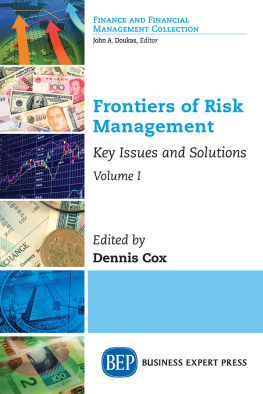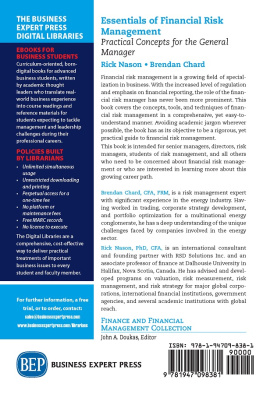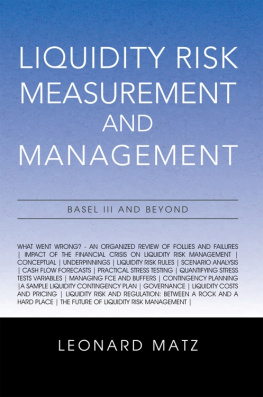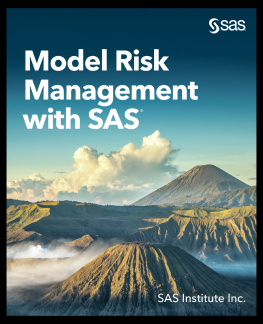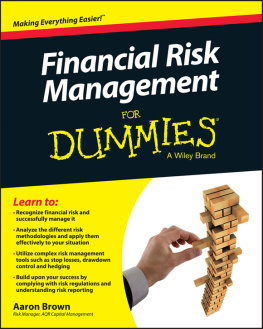
Frontiers of Risk Management
Frontiers of Risk Management
Key Issues and Solutions
Volume I
Edited by
Dennis Cox

Frontiers of Risk Management: Key Issues and Solutions, Volume I
Copyright Business Expert Press, LLC, 2018.
All rights reserved. No part of this publication may be reproduced,stored in a retrieval system, or transmitted in any form or by anymeanselectronic, mechanical, photocopy, recording, or any otherexcept for brief quotations, not to exceed 400 words, without the priorpermission of the publisher.
First published in 2018 by
Business Expert Press, LLC
222 East 46th Street, New York, NY 10017
www.businessexpertpress.com
ISBN-13: 978-1-94709-846-6 (paperback)
ISBN-13: 978-1-94709-847-3 (e-book)
Business Expert Press Finance and Financial Management Collection
Collection ISSN: 2331-0049 (print)
Collection ISSN: 2331-0057 (electronic)
Cover and interior design by Exeter Premedia Services Private Ltd.,Chennai, India
First edition: 2018
10 9 8 7 6 5 4 3 2 1
Printed in the United States of America.
Abstract
Frontiers of Risk Management was developed as a text to look at how risk management would develop in the light of Basel II. With an objective of being 10 years ahead of its time, the contributors have actually had even greater foresight. What is clear is that risk management still faces the same challenges as it did 10 years ago. With a series of experts considering financial services risk management in each of its key areas, this book enables the reader to appreciate a practitioners view of the challenges that are faced in practice identifying where appropriate suitable opportunities. As editor, I have only made changes in the interests of changing regulations but generally have enabled the original text to remain unaltered since it remains as valid today as when originally published.
Keywords
Basel II, credit risk, enterprise risk management, insurance risk, loss data, market risk, operational risk, outsourcing, risk appetite, risk management
Contents
Chapter 1 The Cultural Frontiers of Total Risk Management
Dennis Cox
Chapter 2 Strategic Risk: Bringing the Discussion into the Boardroom
Craig Cohon
Chapter 3 Risk Management and Corporate Finance
Frank Moxon
Chapter 4 The Risk Management of Asset Management
Dennis Cox
Chapter 5 Asset Liability Management in Major Banks
Asif Ahmed
Chapter 6 Treasury and Asset/Liability Management
Thomas Day
Chapter 7 The Risks Within the Hedge Fund Industry
Diccon Smeeton
Chapter 8 Derivatives RiskOTC and ETD
Errol Danziger
Chapter 9 The Simple Art of Monte Carlo
Aaron Brown
Chapter 10 Correlation Causes Questions: Environmental Consistency Confidence in Wholesale Financial Institutions
Michael Mainelli
Chapter 11 Regulation and Credit Risk
Rod Hardcastle
Chapter 12 Citigroups Basel-Ready Tool: The Consolidated Credit Risk Model
Jennifer Courant, Bryce Ferguson, and kos Fels vlyi
Chapter 13 Overcoming the Challenges in the Credit Derivatives Market
Pontus Eriksson
The importance of proper risk management, and the consequences of failure to have it in place, have never been greater. Where failure occurs, not just firms but also individuals may face consequences. The FSAs Director of Enforcement, Margaret Cole, said in 2006 that Failure to manage risks properly is now, more than ever, likely to result in disciplinary action being brought against individuals as well as firms. The FSA has power to censure publicly, fine and even ban individuals from working in the financial services, where there are serious contraventions of the FSA rules.
The Frontiers of Risk Management therefore was initially developed to meet an important need and was well timed. The book was comprehensive in its scope, seeking to cover the entire range of financial services risk management. But that is surely appropriate when firms face so many increasing kinds of risk, not least geopolitical risks and the consequences of climate change. Many of the chapters are extremely topical in terms of current regulatory concern, for example, senior management responsibility (see The risks within the hedge fund industry), and stress testing (see Chapter 17Stress testing and risk management) are all areas on which the FSA has focused recently.
As the regulator was moving toward an increasingly principles-based approach, there was a greater expectation on firms to work out for themselves how to satisfy their regulatory obligations, and that they would have less certainty that they are doing so. Good risk management can help to reduce the uncertainty, and provide a road map for senior management on the key areas that require greater attention (as well as helpful documentary evidence and an audit trail for the regulator). Firms that do this well will enjoy a regulatory dividendless attention and scrutiny from the regulators. Those that have poor risk management will endure more intrusive regulatory examination. However, as Tom Fitzgerald points out in his chapter (The cultural frontiers of total risk management), risk management is not just about satisfying minimum regulatory compliance but is also at the heart of more effective and efficient business management.
Sometimes risk managers are viewed (perhaps not always unfairly) as a specialist breed, inhabiting the dark spaces between compliance and internal audit. This book demonstrates why risk management should be viewed as a core discipline, at the center of an organization. It deserves to be read by a broad audience.
Originally published in 2007 this reissue is after a 10 year period since the original text is now out of print. The original material is largely republished as first issued with minor changes where necessary. With an original objective of being five years ahead of the market, what perhaps is most surprising is that the material remains at the cutting edge of risk management and accordingly of interest to the current risk market.
Dennis Cox
London May 2018
Frontiers of Risk Management was always a bold title for any book to try to live up to. Our objective was simple: to consider the entire spectrum of financial services risk management and to identify the best writers we could who would be able to both appreciate current problems and predict future issues and solutions. We did this in 2007and it is that text which is largely reproduced here. Authors are shown with the positions they held at that time since they wrote based upon their experiences at that time.
While this is an easy objective to write, it is a difficult one for the authors to achieve. Finding authors that really understand the issues, techniques, and practice in the current environment is hard enough. The challenge that we set of asking the authors to go boldly into the future makes this a stimulating and interesting book. I am sure you will agree that all of our authors, each from their own perspective, have risen to achieve these ideals. What is perhaps surprising is that they not only looked to future, but the future they foresaw is still some years away. They were not just a few years ahead, in many cases they were 15 years ahead. When you now read these papers it will be clear to you that people did see the problems that were coming, it was just that firms were not yet acting. In these two volumes of reprint we look at these issues in detail.
Next page
